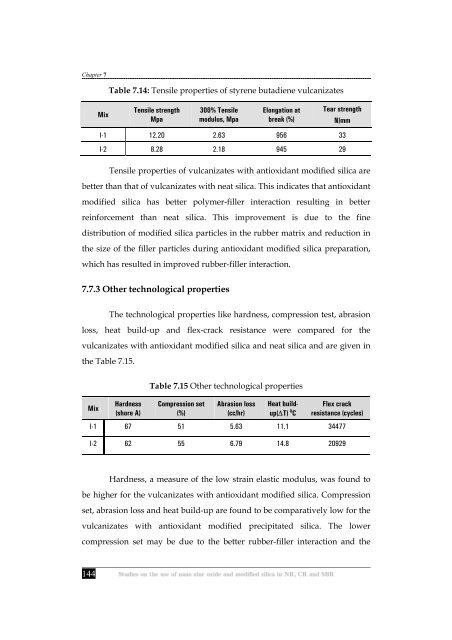Studies on the use of nano zinc oxide and modified silica in NR, CR ...
Studies on the use of nano zinc oxide and modified silica in NR, CR ...
Studies on the use of nano zinc oxide and modified silica in NR, CR ...
You also want an ePaper? Increase the reach of your titles
YUMPU automatically turns print PDFs into web optimized ePapers that Google loves.
Chapter 7<br />
144<br />
Mix<br />
Table 7.14: Tensile properties <strong>of</strong> styrene butadiene vulcanizates<br />
Tensile strength<br />
Mpa<br />
300% Tensile<br />
modulus, Mpa<br />
El<strong>on</strong>gati<strong>on</strong> at<br />
break (%)<br />
Tear strength<br />
I-1 12.20 2.63 956 33<br />
I-2 8.28 2.18 945 29<br />
N/mm<br />
Tensile properties <strong>of</strong> vulcanizates with antioxidant <strong>modified</strong> <strong>silica</strong> are<br />
better than that <strong>of</strong> vulcanizates with neat <strong>silica</strong>. This <strong>in</strong>dicates that antioxidant<br />
<strong>modified</strong> <strong>silica</strong> has better polymer-filler <strong>in</strong>teracti<strong>on</strong> result<strong>in</strong>g <strong>in</strong> better<br />
re<strong>in</strong>forcement than neat <strong>silica</strong>. This improvement is due to <strong>the</strong> f<strong>in</strong>e<br />
distributi<strong>on</strong> <strong>of</strong> <strong>modified</strong> <strong>silica</strong> particles <strong>in</strong> <strong>the</strong> rubber matrix <strong>and</strong> reducti<strong>on</strong> <strong>in</strong><br />
<strong>the</strong> size <strong>of</strong> <strong>the</strong> filler particles dur<strong>in</strong>g antioxidant <strong>modified</strong> <strong>silica</strong> preparati<strong>on</strong>,<br />
which has resulted <strong>in</strong> improved rubber-filler <strong>in</strong>teracti<strong>on</strong>.<br />
7.7.3 O<strong>the</strong>r technological properties<br />
The technological properties like hardness, compressi<strong>on</strong> test, abrasi<strong>on</strong><br />
loss, heat build-up <strong>and</strong> flex-crack resistance were compared for <strong>the</strong><br />
vulcanizates with antioxidant <strong>modified</strong> <strong>silica</strong> <strong>and</strong> neat <strong>silica</strong> <strong>and</strong> are given <strong>in</strong><br />
<strong>the</strong> Table 7.15.<br />
Mix<br />
Hardness<br />
(shore A)<br />
Table 7.15 O<strong>the</strong>r technological properties<br />
Compressi<strong>on</strong> set<br />
(%)<br />
Abrasi<strong>on</strong> loss<br />
(cc/hr)<br />
Heat buildup(∆T)<br />
0 C<br />
Flex crack<br />
resistance (cycles)<br />
I-1 67 51 5.63 11.1 34477<br />
I-2 62 55 6.79 14.8 20929<br />
Hardness, a measure <strong>of</strong> <strong>the</strong> low stra<strong>in</strong> elastic modulus, was found to<br />
be higher for <strong>the</strong> vulcanizates with antioxidant <strong>modified</strong> <strong>silica</strong>. Compressi<strong>on</strong><br />
set, abrasi<strong>on</strong> loss <strong>and</strong> heat build-up are found to be comparatively low for <strong>the</strong><br />
vulcanizates with antioxidant <strong>modified</strong> precipitated <strong>silica</strong>. The lower<br />
compressi<strong>on</strong> set may be due to <strong>the</strong> better rubber-filler <strong>in</strong>teracti<strong>on</strong> <strong>and</strong> <strong>the</strong>

















